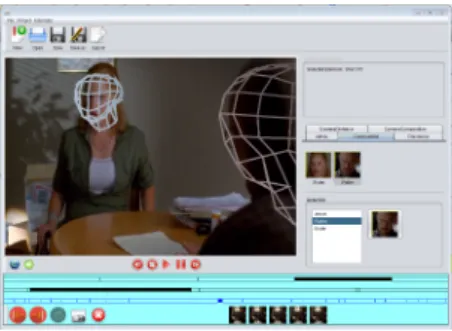HAL Id: hal-01240276
https://hal.inria.fr/hal-01240276
Submitted on 22 Dec 2015
HAL is a multi-disciplinary open access
archive for the deposit and dissemination of
sci-entific research documents, whether they are
pub-lished or not. The documents may come from
teaching and research institutions in France or
abroad, or from public or private research centers.
L’archive ouverte pluridisciplinaire HAL, est
destinée au dépôt et à la diffusion de documents
scientifiques de niveau recherche, publiés ou non,
émanant des établissements d’enseignement et de
recherche français ou étrangers, des laboratoires
publics ou privés.
Insight: An annotation tool and format for film analysis
Billal Merabti, Hui-Yin Wu, Cunka Bassirou Sanokho, Quentin Galvane,
Christophe Lino, Marc Christie
To cite this version:
Billal Merabti, Hui-Yin Wu, Cunka Bassirou Sanokho, Quentin Galvane, Christophe Lino, et al..
Insight: An annotation tool and format for film analysis. Eurographics Workshop on Intelligent
Cinematography and Editing, May 2015, Zurich, Switzerland. pp.57, �10.2312/wiced.20151079�.
�hal-01240276�
EUROGRAPHICS 2014 / B. Lévy and J. Kautz (Guest Editors)
Volume 33(2014), Number 2
Insight: An annotation tool and format for film analysis
B. Merabti, H-Y. Wu, C. Sanokho, Q. Galvane, C. Lino, M. Christie
Figure 1: Geometric tools for annotating framing properties such as head position, size and direction. Features such as shot size (e.g. Close Up) can then be extracted from this annotation, as well as shot type (e.g. Over-The-Shoulder shot).
A multitude of annotation tools and annotation formats for the analysis of audiovisual documents are available and address a wide range of tasks (see Elan [SW08] and Anvil [Kip10]). Existing approaches however remain re-stricted in the visual elements they can annotate on the screen: for example annotating on-screen arrangements of characters so as to evaluate continuity editing over shots is problematic with most annotation tools and languages. It would indeed be beneficial to have an annotation tool ded-icated to filmic studies with a format that would be able to not only provide insight in analytical approaches, but also to support generative approaches, such as reproducing fram-ings and shot sequences in 3D environments from annotated examples of real movies (in a way similar to [RGB13] yet with a more precise annotations). In this paper, we propose an annotation language broadly suited to analytical and gen-erative cinematography systems. The language observes the axes of timing, spatial composition, hierarchical film struc-ture, and link to contextual elements in the film.
Our filmic annotation tool allows flexible and intuitive notation of visual cinematographic elements. First, the an-notation language used by the tool reflects a film structure: a film is composed of scenes, sub-scenes (eg. flashbacks), cuts or transitions, shots and frames.
Then, on top of adding existing textual features to frames, shots, sequences or films (location, characters, event, actions
performed), the key feature of our tool is to perform on-screen annotations dedicated to framing properties. Classical tools such as Anvil [Kip10] for example offer the possibil-ity to place points on the image and label them using text. However annotating all cinematographic features this way is time consuming and is more of a workaround than a practical solution.
In our tool, users select the actor they want to annotate and place a 3D mesh representing a head that they handle in such a way that it corresponds to the desired actor’s position, size and orientation on the image1. For instance, position-ing, rotating and resizing the 3D head is enough to annotate: head and eyes position, as well as orientation and on-screen size, and is a basis to reason on shot size and shot angle. For a given shot, only key-frames are annotated. Key-frames are automatically proposed and users can insert or remove them. The annotation tool is made available to the commu-nity†with a presentation of the annotation format.
The design of such a language opens many possibilities including analytical research on the style, positioning of the camera, and precise framing as well as in generative systems where camera framings and styles can be replicated using the annotations in virtual 3D environments with applications to automated and interactive cinematography.
The wealth of data collected in the annotation combined with learning techniques could also bring deeper understand-ing to the cognitive science behind cinematography, which would help us design more sophisticated and user-adapted camera planning techniques and systems.
References
[Kip10] KIPPM.: Multimedia annotation, querying and analysis in anvil. Multimedia information extraction 19 (2010).1
[RGB13] RONFARDR., GANDHIV., BOIRONL.: The Prose Sto-ryboard Language: A Tool for Annotating and Directing Movies. In WICED 2013 (Chania, Crete, Greece, 2013).1
[SW08] SLOETJESH., WITTENBURGP.: Annotation by cate-gory: Elan and iso dcr.1
† http://cinematography.inria.fr/Insight
